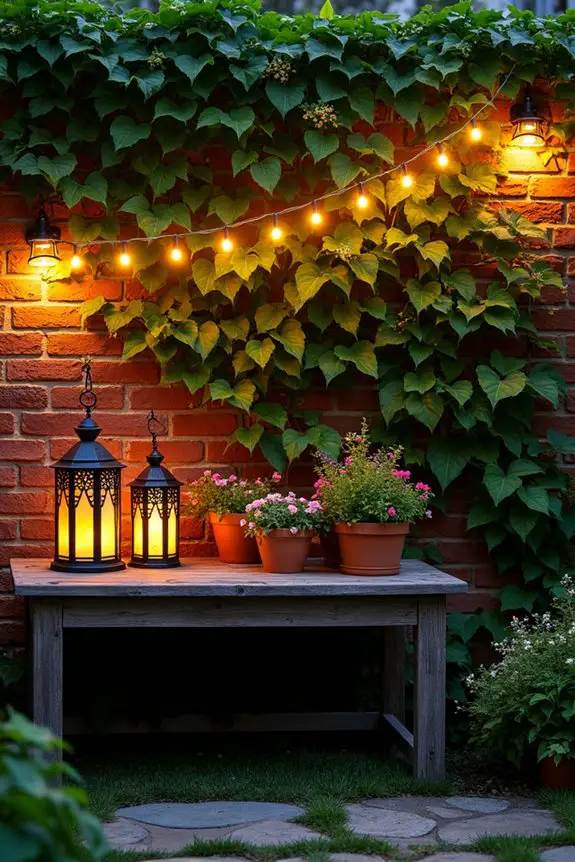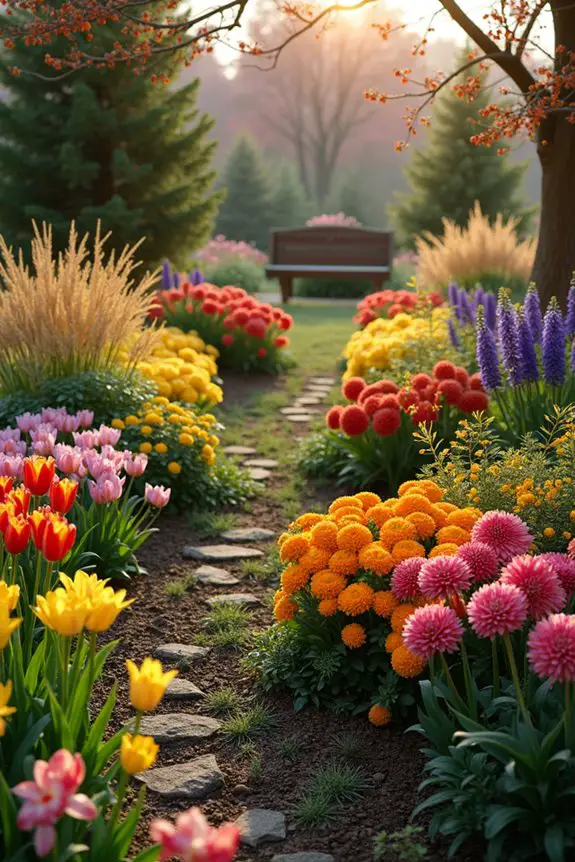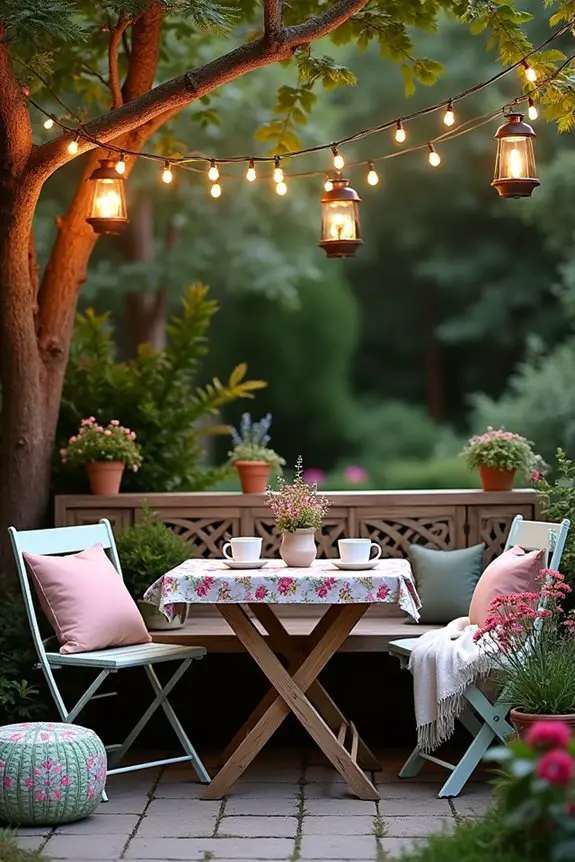Imagine your garden at night, transformed into a magical escape where each light is a tiny star guiding your way. Let’s face it, who doesn’t want their backyard to sparkle like a fairy tale? From charming pathway lights to dreamy string lights overhead, there are so many ways to illuminate your space. Have you ever thought about using spotlights on your favorite plants? Stick around to explore these lighting ideas that could make your garden the place to be after dark.
Creative Lighting Arrangements
When it comes to creative lighting arrangements, you’ve got a whole playground of options at your fingertips.
Think about how pathway accent lighting can guide friends like a warm hug, or how hanging string lights overhead can transform your space into a cozy café.
And don’t forget those spotlights on your favorite plants—they can show off your green thumb like a trophy on the shelf.
1. Pathway Accent Lighting

When it comes to garden lighting, pathway accent lighting is a game-changer. It’s not just about lighting up the path; it’s about setting a mood, creating a welcoming vibe, and making your garden feel like an enchanted destination. Imagine this: soft, warm glows guiding your guests along beautifully landscaped routes. How lovely is that? It’s functional too, helping prevent those embarrassing missteps when someone trips over a stray garden gnome in the dark.
Now, let’s talk creative arrangements. One idea is to scatter solar-powered LED lights along the path, spaced out evenly but with a little twist—a mix of heights! You can use taller lights flanking the pathway and shorter ones artfully placed within flower beds. This creates a dynamic feel. It’s like your garden is throwing a little party, each light shining bright with its personality. Moreover, using specialized UV grow light sterilizers can help maintain healthy plant growth, ensuring your flowers stay vibrant year-round.
You might prefer string lights draped along the edge, or even hanging from low tree branches. It’s cozy and whimsical, almost like you’re inviting fireflies over for tea. Can you imagine? Just make certain the lights are weather-resistant, so you don’t have to chase away soggy string lights like I did last summer.
Another fun idea? Try using lanterns—either on stakes or hung from shepherd hooks lining your walkway. You can go for classic metal ones or even those charming glass jars filled with fairy lights. They can give your garden a magical fairy-tale touch. Just be careful when you hang them; I once put a lantern way too close to my rosemary bush. Let’s just say, I learned the hard way that thyme waits for no one when it comes to fire hazards.
Don’t forget about colors! Warm whites create a soft and inviting atmosphere, while colored LED lights can add a playful twist, perfect for summer gatherings or festive occasions. Who doesn’t love a good mood bite? Additionally, incorporating solar lantern string lights can further enhance the enchanting atmosphere of your outdoor space.
2. Hanging String Lights Overhead
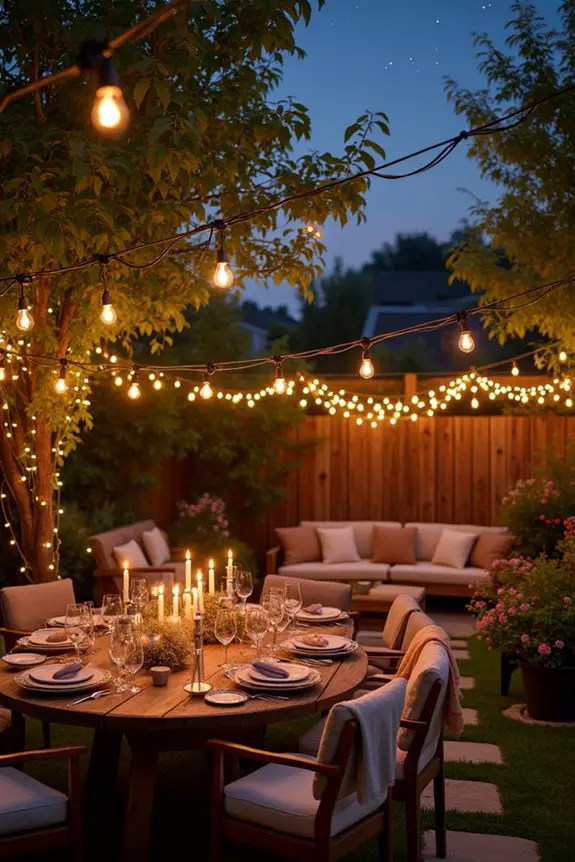
When it comes to creating that dreamy atmosphere in your garden, hanging string lights overhead are like the cherry on top of a sundae. They bring a cozy, enchanting vibe that feels just right for leisurely summer evenings and lively garden parties. Plus, they’re functional—offering both light and a whimsical touch to your outdoor space. You know those moments when you look up and just feel that sparkle? It’s like the stars decided to join your gathering.
Now, let’s explore how to arrange these beauties. First, consider the layout of your garden. Are there trees, arbors, or pergolas? These structures are your best friends! Start by securing the string lights to the branches or beams. As a personal tip, pacing yourself is key—trust me, I’ve tangled lights like a cat does with yarn. Incorporating a garden weather station can help you monitor the conditions and choose the best nights for lighting up.
It’s a bit of a workout, but you’ll find that you can create interesting patterns by hanging the lights at different heights. Picture a graceful arch over your dining area or gentle draping across a cozy seating nook. It draws the eye and makes everything feel just a little more inviting.
Another fun idea is to incorporate various bulb designs. Mixing globe bulbs with more traditional Edison-style ones adds a layer of visual intrigue, like your garden’s dressing up for a special occasion. And don’t forget to think about how much light you actually need. You might want the area over the dining table to be a bit brighter, while the lounge area can bask in a softer glow.
It’s all about balance—kind of like trying to figure out how many marshmallows to put in hot cocoa.
If you’re going for a more laid-back vibe, consider winding the lights around trellises or fences. It’s like adding a light-draped canvas to your garden, giving it that dreamy chic touch. Just remember to check that your lights are rated for outdoor use. I once bought a set that was meant more for indoor use, and let’s say they didn’t survive the first rain. Lesson learned, folks—it’s worth the extra bucks to keep your garden shining bright. An essential garden deck storage box can also help to keep your lights organized when not in use.
Lastly, don’t be shy about using a dimmer switch if your lights support it. You can create different moods just with the touch of a finger—bright and cheerful during family dinners, soft and romantic when you’re curled up with that special someone under the stars.
3. Spotlight on Focal Points
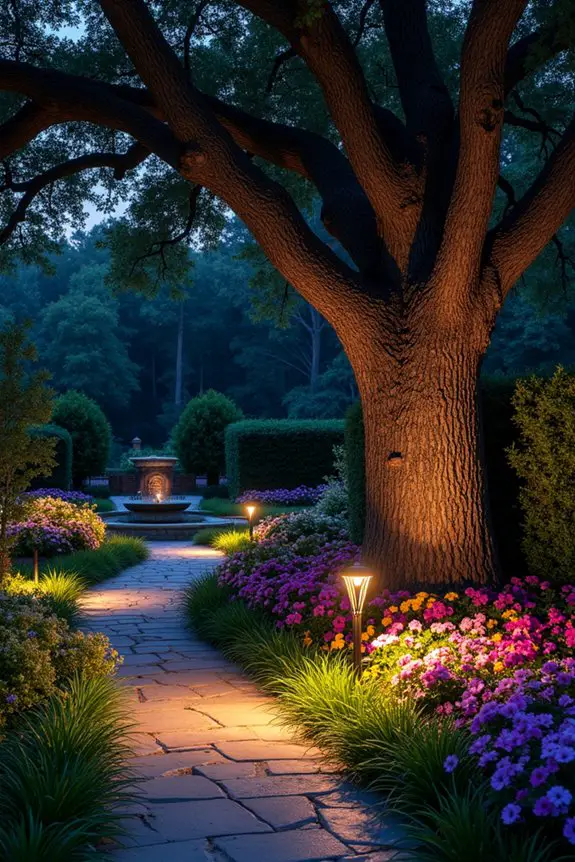
When thinking about adding some flair to your garden, nothing quite does the job like spotlighting your favorite focal points. This lighting design idea not only emphasizes the beauty of the unique features in your outdoor space, but it also creates a warm, inviting atmosphere—making everything look a little more magical after sundown. Imagine highlighting a grand oak tree or your stunning flowerbed. This approach is perfect for showcasing what you love and giving your garden a touch of elegance.
First things first, identify your focal points. This could be anything from a sculpture, a water feature, a beautiful flowering plant, or even a stunning tree. Once you’ve determined what you want to highlight, grab some spotlights. LED spotlights are a fantastic choice; they use less energy and come in a variety of styles. Plus, they don’t emit that much heat—so you won’t turn your lovely lilies into wilted wonders. Consider incorporating solar stake path lights, which are not only energy-efficient but also add a charming glow along your pathways.
Now, let’s talk placement. You want to angle the lights to beam directly on your focal point, making it really pop at night. Consider the distance from the light to the object; if it’s too close, you might create harsh shadows, and if it’s too far away, you won’t see much at all. It’s a bit like cooking—you wouldn’t want to serve a dish that’s too salty, right? You’ve got to find that sweet spot. A little trial and error can help, so don’t get frustrated if it takes a few positions to get it just right.
Next, think about the height of your spotlights. A low angle can add drama, like that time I tried to imitate a grand chef and ended up with a soufflé that collapsed. For trees or larger features, position the lights at the base and angle them up. But for smaller garden adornments, you might want to set the lights higher, aiming down. It’s all about creating those soft glows versus harsh rays. And remember, you don’t want a spotlight to feel like a blaring spotlight; it should feel more like a cozy hug instead.
Also, consider using dimmable spotlights if you can. This feature is a game changer, allowing you to adjust the brightness depending on your mood—more mellow when you’re enjoying a glass of wine, brighter for evening gatherings with friends. It’s flexibility at its best, akin to having various spices at your disposal; a little tweak here and there can transform the whole dish, or in this case, the whole scene.
Lastly, don’t forget to play around with colored filters if you’re feeling adventurous. A soft blue can evoke calm, while a warm amber can create intimacy. It’s a fun way to set the mood. Just be mindful of your overall garden theme—unless you’re going for a circus vibe; then, the sky’s the limit.
4. Symmetrical Plant Bed Lighting

When it comes to creating a visually appealing garden, symmetrically lighting your plant beds can work wonders. Not only does it help showcase your greenery, but it also adds a touch of order and elegance to your outdoor space. If you’ve ever seen perfectly aligned garden beds lit up at night, you know just how enchanting it can be—the soft glow casting gentle shadows, accentuating the beauty of your plants while providing a cozy ambiance.
First, pick a symmetrical planting layout. Think of it like balancing the ingredients in your favorite recipe. Whether it’s identical flower beds on each side of a pathway or mirroring shrubbery that flanks your entryway, symmetry creates a sense of harmony. So, take a moment to evaluate your garden’s layout and decide where symmetry comes into play.
Next up, choose your lighting fixtures. You can opt for stakes that shine upward or even some decorative lanterns that light up pathways. LED fixtures are again the top contender, delivering energy-efficient light that’s as easy on your wallet as it’s on the eyes. I mean, who doesn’t love a garden that looks stunning and isn’t draining their bank account?
Once you’ve got your fixtures, it’s time to position them. You’ll want to place your lights evenly along the edges of your planted beds. If they’re too far apart, you risk having dark patches that feel a bit like the last round of my attempts at baking a soufflé—flat and uninspiring. On the other hand, if they’re too close, you might end up with wild shadows that make your plants look a bit like they’re auditioning for a horror movie. Aim for about six to eight feet apart; that’s usually just the right distance to keep the glow consistent without overpowering your flowers with direct beams.
Think about height now. Lower lights provide a soft, subtle glow—perfect for creating a romantic vibe, much like a dinner we always picture in fairy tales. If you’ve got taller plants, aim your lights to illuminate from the base upwards, highlighting the leaves and flowers without being too intrusive. For shorter plants, place lights at a height that casts downward, letting their colors shine without feeling competitive. It’s like giving your plants the microphone at an open mic night—let them take center stage without drowning them out.
If you’re feeling really fancy, consider a dimming option. Just like I adjust the heat when frying an egg to avoid a burnt mess, having adjustable lighting lets you create the perfect mood for any occasion. Brighten things up for a lively evening gathering or dial it back for a quiet night with just you and your thoughts.
5. Layered Lighting for Depth
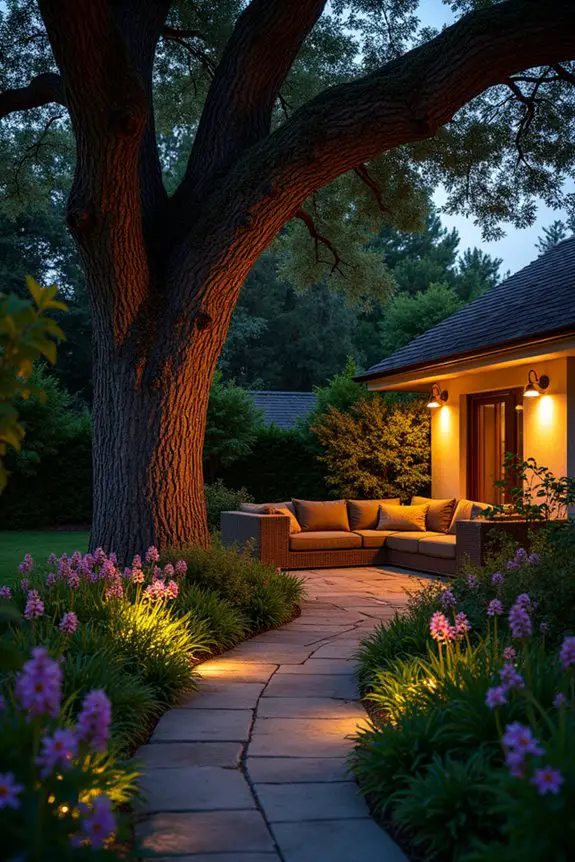
Layering your garden lighting is kind of like building a delicious lasagna. You need different layers to add depth and texture, and when done right, it creates a delightful experience for the eyes and the heart. By mixing different types of lighting—think uplights, downlights, and spotlights—you’re not just illuminating your garden, you’re crafting a unique atmosphere. This layered approach turns your outdoor space into a tasteful retreat, where every corner invites exploration, and no shadow feels lonely.
Start by identifying key features in your garden that you want to highlight—like that gnarled old tree that looks like it’s seen more sunsets than you have, or your flowerbeds bursting with color. These are your hero elements, all set to shine in the spotlight (no pun intended).
Once you know what you’re showcasing, it’s time to decide on the types of lights you’ll use. You might consider using some uplights to give those tall plants a dramatic boost, while downlights create a warm glow that dances off pathways and lower plantings, guiding your guests gracefully through your floral wonderland.
Next, think about where to place these lights. If you’ve got that gnarled old tree, aim an uplight towards its trunk to cast beautiful shadows on the surrounding area. For the flowerbeds, try using low-level, soft lights that wrap around them like a warm blanket. That way, at night, it’s like your flowers are surrounded by a glowing halo. Isn’t that a lovely image?
And hey, be a little playful with your placement. I once put a spotlight on a random garden gnome and ended up with the most ridiculous ‘Shining Gnome of Glory’ in my yard—perhaps not the vibe I was going for, but it did crack me up every time I walked past it.
Just remember, balance is key. You don’t want one side of your garden to feel like prime real estate while the other side feels like a forgotten alley. Aim for a mix that feels harmonious and encourages movement throughout your garden.
Finally, consider using dimmable lights for added flexibility. Some evenings, you might want just a soft romantic glow, while others call for a brighter, cheery atmosphere, like a family gathering or an impromptu dance party (after a few too many glasses of wine, of course).
Adjusting your lighting to suit your mood can transform your outdoor space into the perfect setting, whether it’s intimate, playful, or somewhere in between. With a little creativity and planning, layering your garden lights can turn your space into something truly enchanting.
6. Zoned Lighting for Different Areas
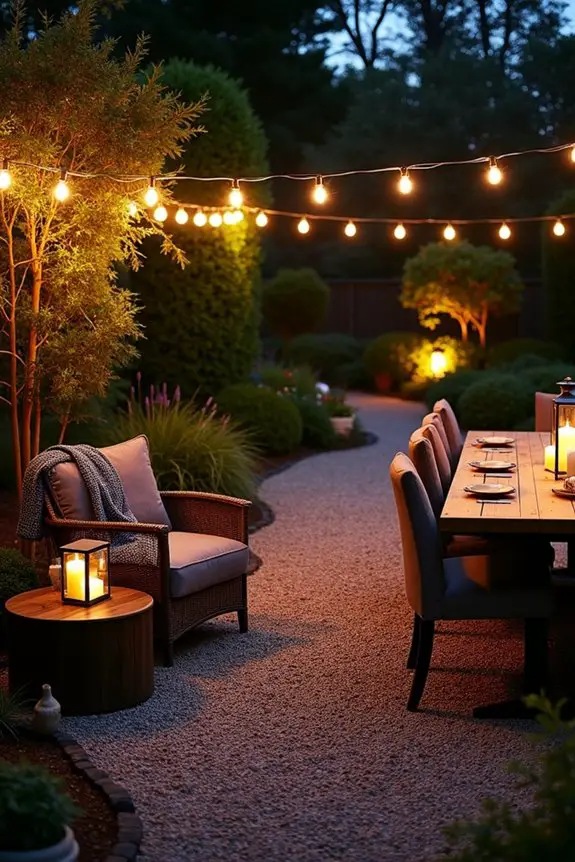
When it comes to garden lighting, zoning your outdoor areas is a game-changer. Think of it like setting the table for a dinner party — you wouldn’t put the salad, main course, and dessert all in one bowl, right? Different zones in your garden serve different purposes, and lighting them accordingly creates a perfect balance of practicality and charm. The right lights can make your cozy reading nook feel intimate, while a lively gathering spot can turn into the life of the party.
Start by identifying the key areas of your garden that you want to illuminate. Do you have a tranquil seating area where you sip tea and watch the sunset? Or perhaps an outdoor dining space that’s ripe for summer BBQs? Each zone should have its own distinct lighting style to match its unique vibe. For example, consider using string lights or soft pendant lights around your dining area to create a warm, inviting atmosphere, perfect for lingering conversations, while a cute little reading nook may benefit from gentle lanterns that cast a soft glow, encouraging you to curl up with a good book.
Now, let’s talk about placement. Visualize this: a wonderfully lit dining table surrounded by flickering candles, with soft lighting set at just the right angle to emphasize your favorite garden features in the background. It’s all about creating layers and textures, just like a well-cooked lasagna—each part contributing to something beautifully harmonious.
Use wall sconces or spotlights to draw attention to specific spots, like your flourishing herb garden or that unfortunate garden statue you bought on a whim (we all have one of those, right?).
And hey, don’t forget about the pathways. Properly lit paths can guide your guests safely through your yard, making them feel like they’re in a magical outdoor wonderland rather than a spooky horror movie set. You can use low fixtures along the edges of the paths or even solar-powered lights to save energy and keep it eco-friendly. Just imagine the delightful click of heels on cobblestone or the soft crunch of gravel underfoot, all while being illuminated by gentle, inviting lights.
Consider the mood you want to set in each zone. For peaceful evenings in your cozy nook, opt for dimmer lights or soft fairy lights that twinkle like stars. In contrast, your gathering spot can have brighter, more vibrant lighting for those lively BBQs and parties. Think of lighting as that secret ingredient that can transform the dish entirely—it can change everything about the vibe of your gathering.
Lastly, keeping it flexible is key. Use smart lights or dimmers to make adjustments based on the occasion. After all, one day you might be hosting a peaceful dinner for two, while the next could call for a lively group of friends belting out tunes while grilling.
With a bit of creativity and thought, zoning your garden lighting can create an enchanting and functional outdoor space that entices exploration and enhances enjoyment every single night.
7. Pathway Lighting Grid Design
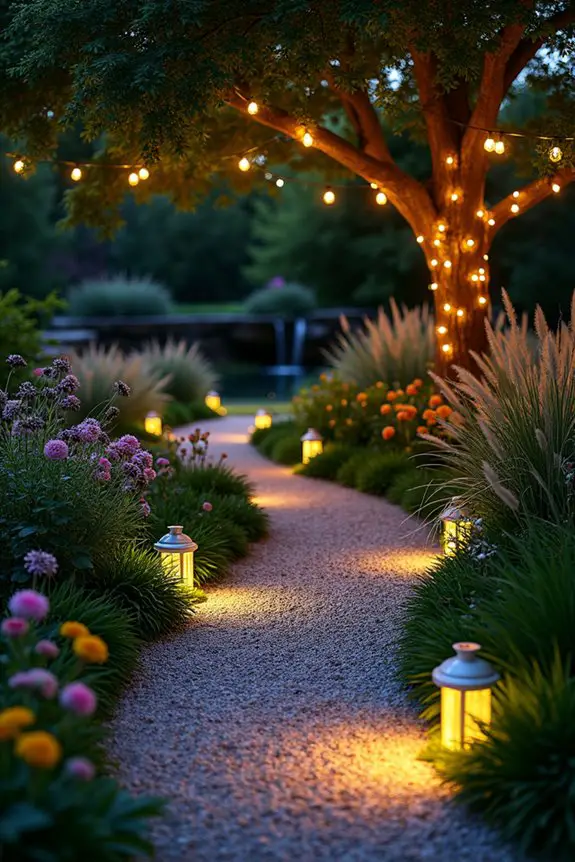
Have you ever strolled through a garden at night and felt like you were in a fairytale? That’s the magic of pathway lighting. Not only does it keep you from tripping over those sneaky roots or rogue garden gnomes, but a well-designed lighting grid adds a level of charm that transforms your garden into an enchanting evening retreat.
Imagine your guests gliding along a beautifully lit path, each step guided by twinkling lights, while the surrounding greenery casts fascinating shadows.
So, how do you create this effect? Let’s break it down into bite-sized pieces. First, when planning your lighting grid, think about the layout of your pathways. Straight paths can benefit from evenly spaced lights on either side, like a well-stirred pot of spaghetti, keeping everything nice and neat. For curved paths, consider staggered lighting. This approach won’t just light the way; it will also highlight the gentle curves, making your garden feel more organic.
Next, determine the type of lights you want to use. You could go with low voltage LED path lights for a classic look, or, if you’re feeling adventurous, opt for solar lights that can soak up the sun during the day and dance to life come nightfall. They’re like garden superheroes, saving energy while illuminating the way.
Remember to place them about 6 to 8 feet apart—too close, and it’s like piling too many toppings on a pizza; too far, and you might as well be walking through a haunted house.
Once you’ve settled on placement, take a moment to adjust the angles. Aim your lights slightly towards the ground to avoid blinding anyone trying to enjoy that intimate evening. Alternatively, have them point at your favorite plants or rocks—everyone loves a good spotlight, after all. This won’t just light your path; it’ll create alluring focal points that draw the eye and set the mood, inviting people to linger a bit longer.
Lastly, consider the color of your lights. Warm white tones are perfect for creating a cozy feel, while cool tones may bring a more sophisticated vibe. Mix it up, if you’re brave! Just like a good salad needs that crunch from nuts, a delightful garden might need varying light hues to keep it vibrant.
And here’s a little personal anecdote: I once got overly ambitious and decided to add a few of those colored solar lights along my path, thinking, “Why not bring a carnival to my backyard?” Turns out, my garden looked more like a disco than a serene pathway, which melted into delightful laughter among my friends as they tried to walk through.
Lesson learned, moderation is key, even in garden lighting.
With these tips, you’re all set to create a path that’s not only functional but also sets the stage for magical nights under the stars. It’s the perfect combination of practicality and charm, don’t you think? So grab your lights and start designing your very own illuminated garden path; just be careful about the disco vibes.
8. Circular Lighting Around Tree
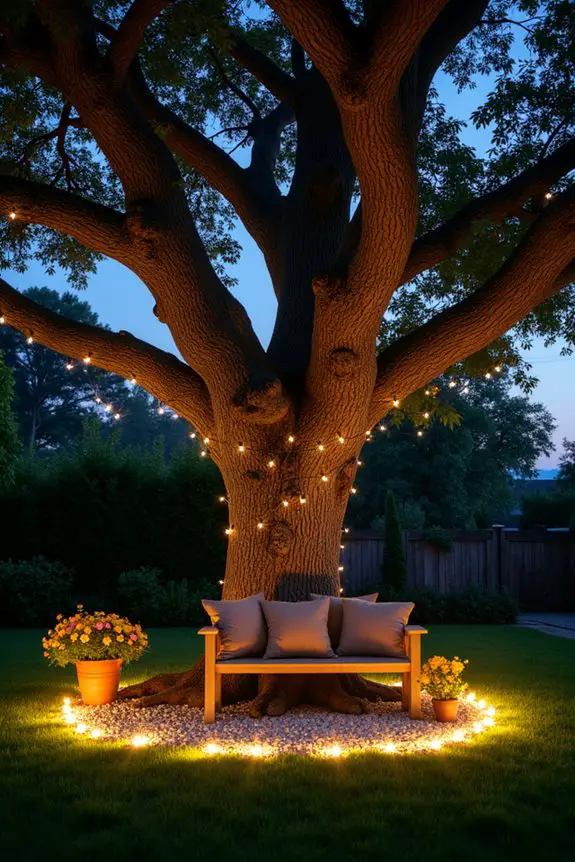
When it comes to garden lighting, circular lighting arrangements around trees are an absolute game-changer. Envision sitting under a tree lit up like a gentle starry night. It not only offers beautiful illumination but also creates a cozy nook that invites you to unwind with a good book or your favorite cup of tea. Plus, these circular setups can bring out the tree’s natural beauty, making it a stunning focal point in your garden.
To get started, think about the size of your tree and the space around it. A good rule of thumb is to create a circle that’s about 4 to 6 feet in diameter from the tree trunk. This gives you room to maneuver while still keeping things snug. Place a few lights evenly around the perimeter. Low voltage LED lights work wonders here—they offer a warm glow, like twinkling stars. If you’re feeling a bit fancier, fairy lights strung around the branches can add that magical twinkle, elevating the moment even further.
Now, how do you actually set this up? Picture this: after you’ve measured your circle, stake your lights into the ground, keeping them about 3 to 4 feet apart. This spacing is essential; too close and it could look like a runway, too far and you might as well use a flashlight.
Once your lights are in place, stand back and enjoy the sight. You might even want to give a little spin to see how lovely it looks from different angles—finding that perfect perspective is key! Adjust the angles of the lights so they create an inviting umbrella of warm light underneath the tree. You’ll want them pointing slightly upwards to showcase the leaves and branches as well—a glorious way to transform your ordinary tree into a showstopper.
And don’t forget the color! Soft white lights will bring a calm vibe, while colored bulbs can add a fun and whimsical touch, especially for gatherings or playful summer nights.
Speaking of summer nights, I once tried to set up a circular lighting display around my docile old oak tree. I envisioned a serene escape, perfect for evening gatherings. But in my excitement, I chose bright multi-colored lights—let’s just say my garden resembled a circus tent more than a tranquil retreat.
Cue my friends showing up at 9 PM, thinking they’d stumbled upon a rave instead of a cozy evening. Lesson learned: stick to warm, inviting hues if you want to charm your guests, not confuse them.
9. Geometric Pattern Lighting Arrangement
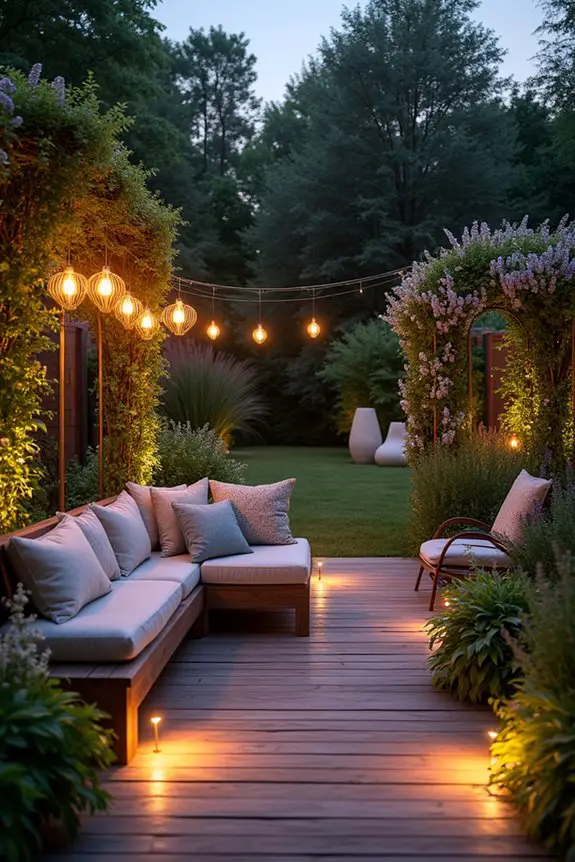
When you think of adding a little pizzazz to your garden lighting, geometric pattern lighting arrangements can work wonders. They’re not just functional, but they create an artistic vibe that elevates your outdoor space. Imagine the cool look of crisp patterns lighting up your pathways or seating areas, almost like the stars twinkling in a well-structured constellation. Isn’t that a delightful idea?
To start off with this design, pick your favorite geometric shape. Whether it’s triangles, hexagons, or even squares, considering the geometry can bring an edgy feel to your garden. Space is important here—imagine your lighting radiating evenly and making a statement. If you’re going for triangles, for example, you could alternate rows of lights along your garden path or even around shrubbery.
Here’s how to get those shapes lit up! First, clear the area where you want your lights to shine. You need a blank canvas, right? Then, map out your patterns with string or rope. For a triangle layout, think of three points forming the corners. A pattern like this can create clear distinctions in your garden, leading guests from one area to another.
Trust me, when you simplify the layout like this, your planning process just got a lot easier—kind of like choosing a slice of pizza over a gourmet meal when you’re starving!
Next, gather your lighting. I recommend low-voltage LED lights in warm hues to keep those cozy vibes in check. Depending on the shape, stake your lights down at the previously marked points. Make sure they’re evenly spaced—about 3 to 4 feet apart works well for most setups. If you’re feeling creative, you can mix different lighting styles, like garden stakes and hanging lights, to give your geometric patterns more depth and variety.
Once everything is installed, step back and really look at your design. I remember the time I did this and realized I’d ended up with a weird zig-zag pattern that looked more like a poorly drawn lightning bolt than the triangles I planned. Talk about a garden critique session with my family!
But with some adjusting, I managed to straighten things out, and the result was a chic, modern look my guests raved about.
The final touch? Add a little flair with colored bulbs or optional dimmers. You can adjust the brightness based on your mood—from bright and lively to soft and intimate, just like switching from coffee to herbal tea in the evening.
Choosing the right lights can define your space and set the mood you’re aiming for, whether it’s for an extravagant dinner party or a quiet night under the stars. Just remember, whichever pattern you choose, a universal rule remains: be playful, make mistakes, and enjoy the glowing transformation your garden deserves.
10. Vertical Garden Light Installation
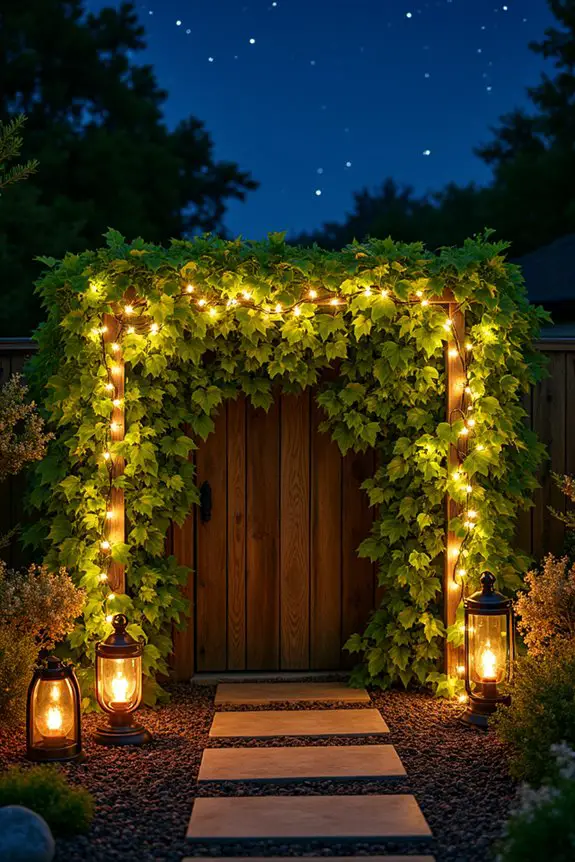
Looking to elevate your garden’s vibe while making it both functional and stylish? Vertical garden lighting is the way to go. Not only does it brighten up the space, but it also creates a stunning visual appeal that can transform ordinary walls and fences into something spectacular. Imagine a cascade of light dancing off lush greenery or illuminating your favorite floral arrangements—sounds dreamy, right?
So, let’s plunge into how you can make this magical lighting work in your own garden. First things first, choose the right spot. Look for a vertical surface like a wall, fence, or trellis that could use a pop of illumination. This allows you to highlight your plants and create that enchanting glow after sunset. You want your lighting to highlight the beauty of your greenery without overwhelming it—think of it as adding a sprinkle of salt to your favorite dish, just enough to elevate the flavors.
Now that you have a location picked out, it’s time to gather your materials. I can’t stress this enough—go for durable, weather-resistant lights, preferably LED, as they’re energy-efficient and long-lasting. You can opt for wall-mounted fixtures, string lights, or even solar-powered stake lights, depending on the atmosphere you want to create. If you really want to be the superstar of garden lighting, consider using programmable smart lights—imagine the thrill of changing colors with just a tap on your smartphone!
Once you’ve got your lights ready, it’s installation time! Start by measuring the area to determine how many lights you’ll need to cover the vertical space effectively, while keeping them evenly spaced. Comes in handy to remind yourself, more isn’t always better. Picture last Thanksgiving when I overcooked the turkey, only to find a dry, sad centerpiece instead of a succulent feast. Less can definitely be more, especially with lighting arrangements.
When it comes to installation, make it simple. Use hooks or brackets to mount wall lights, or hang string lights in a zig-zag pattern for a whimsical touch. If you’ve got climbing plants, wrap some lights around them; it’s like giving your garden a sparkly dressing. Just be mindful of the wattage. Too bright can be blinding, whereas too dim may feel lackluster—kinda like that one time I baked a soufflé, only for it to collapse before I could impress anyone.
After you’ve installed your lights, turn them on and step back. Do a little dance, or at least a shimmy, because you’re about to see your garden come alive! If something looks off, don’t panic; sometimes, a few minor adjustments can make all the difference. Like that one time our family Halloween decorations turned into a scene from a horror film instead of festive fun, but with a few tweaks, we nailed it.
And don’t forget the finishing touches! You might consider adding textured elements, like lanterns or reflective surfaces, to amplify the light’s effect. Or use colored bulbs to create a mood: warm for coziness, or cool for romantic vibes. Trust me, matching your garden lighting to your evening’s activities can be just like matching your outfit to the occasion—who doesn’t want to feel fabulous anytime they step outside?
Energy-Efficient Lighting Options
Finding the right energy-efficient lighting for your garden can feel a bit like trying to choose the perfect spice for your favorite dish—there are so many options, and not all of them will bring out the best flavors.
Start with LED lights; they’re like the salt of garden lighting ideas—versatile and cost-effective.
Solar lights are a great choice too; just like sun-kissed tomatoes, they bask in the sunlight and work their magic at night.
Want to get fancy? Try smart lighting, which lets you control everything from your couch, making you feel like a garden wizard.
Just don’t go overboard; too many lights can be like too much garlic—overpowering the whole meal.
Choose wisely, and your garden will shine!

